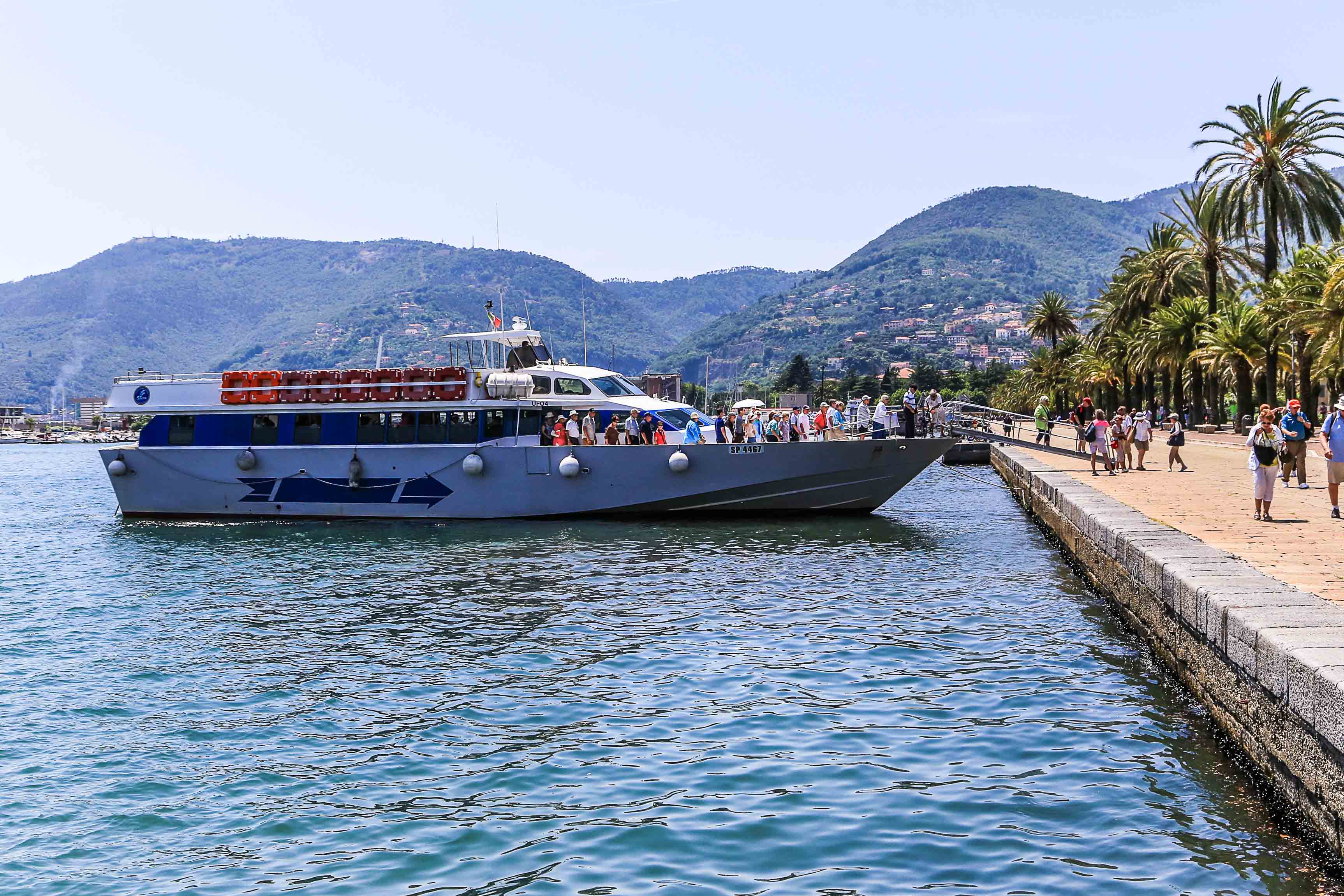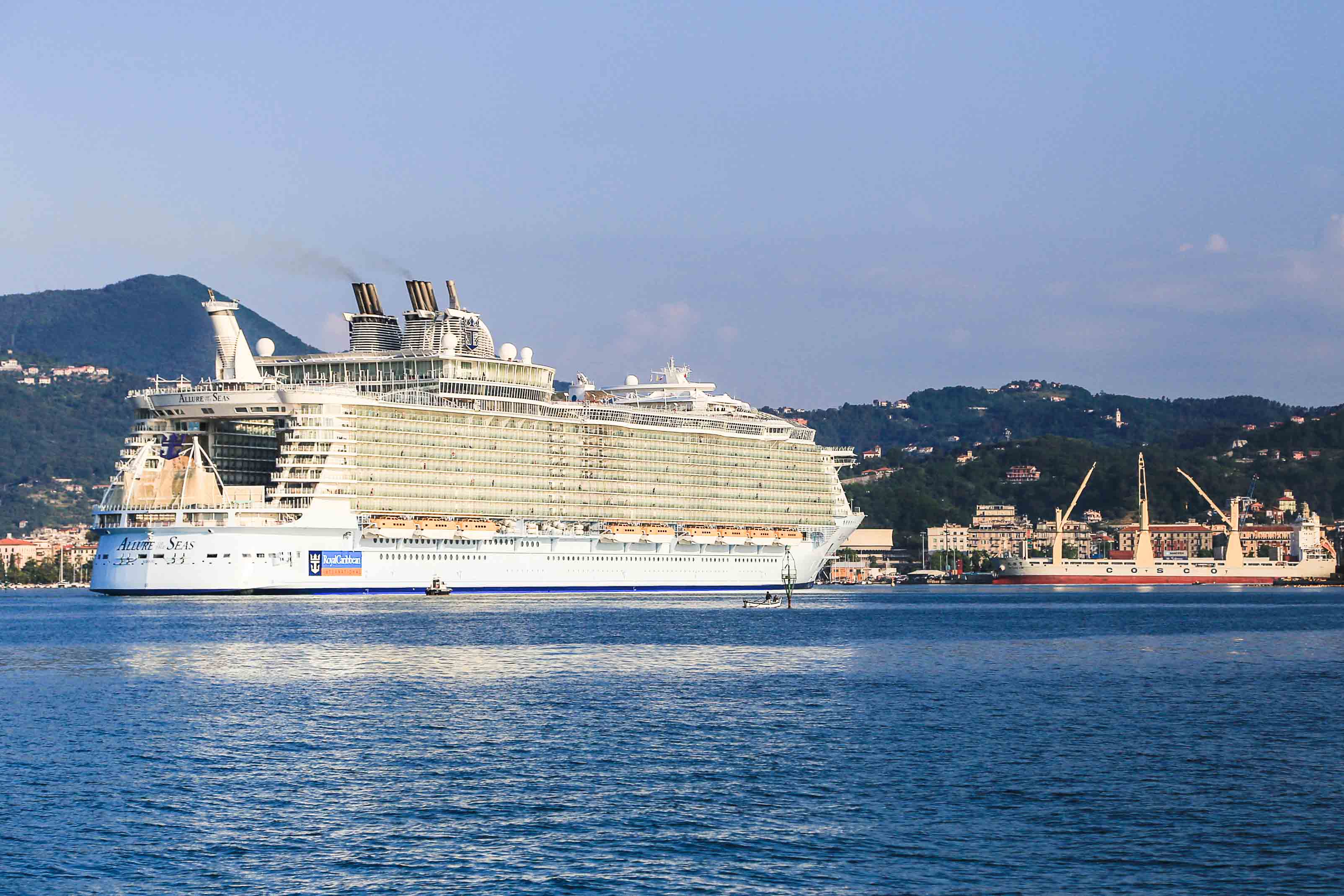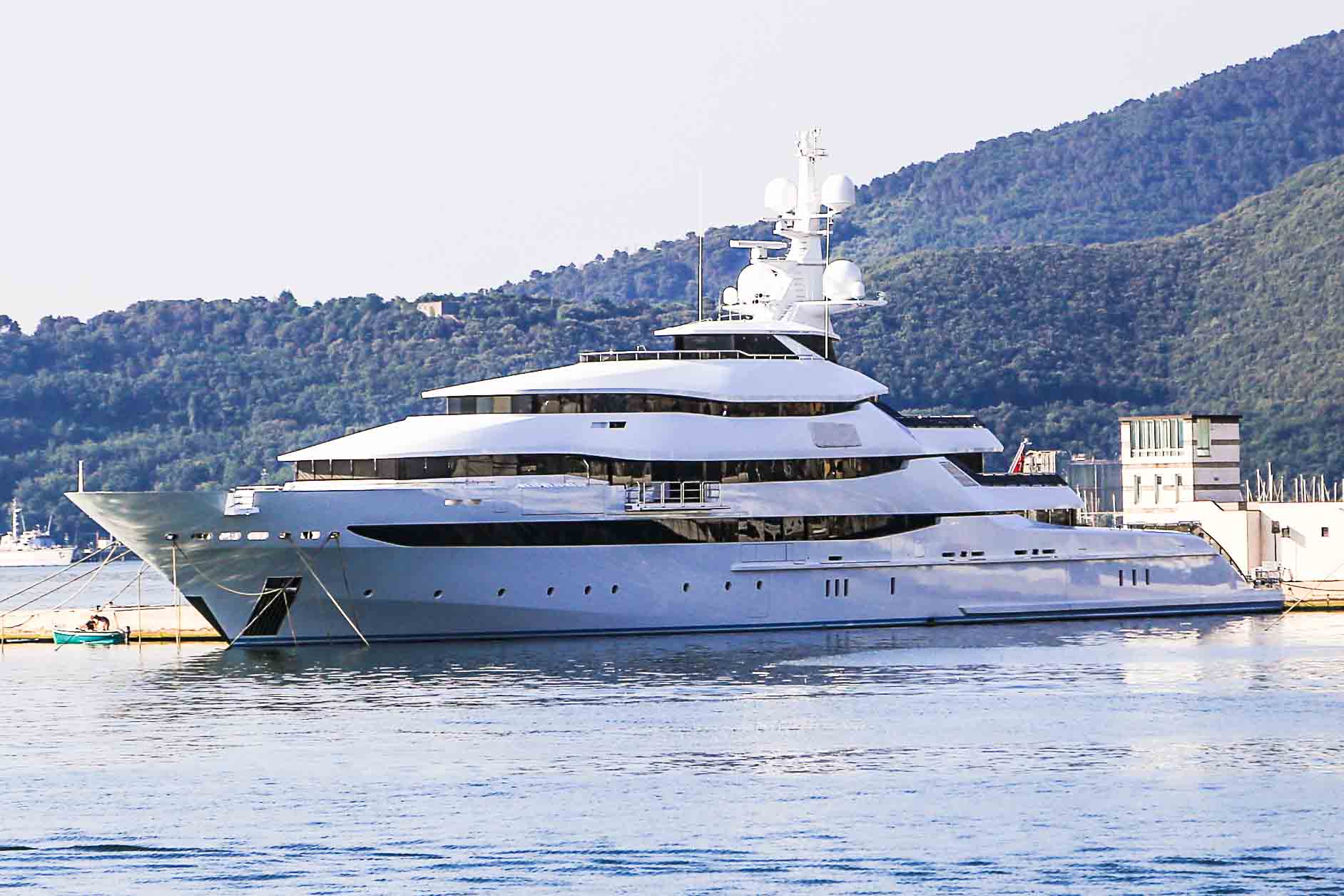La Spezia, Italy
Our scheduled tour today was called “A Cruise to Cinque Terra”. The idea was to meet in the theater at 7:30 am, take the tender to shore and get on a boat that would cruise to one of the 5 seaside villages while viewing all the others. It was a beautiful day although there was the typical morning light haze. Margaret had decided that she wouldn’t go on this tour yesterday when they changed the departure time from 8:00 to 7:30 am. A quick breakfast at La Veranda and I was on my way.
Following write-up is my updates and corrections of Wikipedia’s article on this area:
The Cinque Terre is a rugged portion of coast on the Italian Riviera. It is in the Liguria region of Italy, to the west of the city of La Spezia. The area, literally translated, “The Five Lands”, comprises five villages in order from the farthest away to closest: Monterosso al Mare, Vernazza, Corniglia, Manarola, and Riomaggiore. The coastline, the five villages, and the surrounding hillsides are all part of the Cinque Terre National Park and is a UNESCO World Heritage Site.
The first historical documents on the Cinque Terre date back to the 11th century. Monterosso and Vernazza sprang up first, while the other villages grew later, under military and political supremacy of the Republic of Genoa. In the 16th century, to oppose the attacks by the Turks, the inhabitants reinforced the old forts and built new defense towers. From the year 1600, the Cinque Terre experienced a decline which reversed only in the 19th century thanks to the construction of the Military Arsenal of La Spezia and to the building of the railway line between Genoa and La Spezia. The railway allowed the inhabitants to escape their isolation, but also brought about abandonment of traditional activities. The consequence was an increase in poverty which pushed many to emigrate abroad, at least up to the 1970s, when the development of tourism brought back wealth. A good example of unforeseen consequences of technology.
The variation of house colors is due to the fact that while fishermen were doing their jobs just offshore, they wanted to be able to see their house easily. This way, they could make sure their wives were still home doing their wifely duties. Most of the families in the five villages made money by catching fish and selling them in the small port villages. Fish was also their main source of food.
Over the centuries, people have carefully built terraces on the rugged, steep landscape right up to the cliffs that overlook the sea. Part of its charm is the lack of visible corporate development. Incredible hiking paths, unbelievably trains and boats connect the villages. A passenger ferry runs between the five villages, except Corniglia. The ferry enters Cinque Terre from Genoa’s Old Harbour and La Spezia, Lerici, or Porto Venere.
There are few roads into the Cinque Terre towns that are accessible by car. The one into Vernazza was opened in June 2012, but very narrow at many spots. It leads to a parking area half a mile from town. It is best to plan not to travel by car at all, but to park at La Spezia, for instance, and take the trains. Local trains from La Spezia to Genoa and the rest of the region’s network connect the Cinque Terre. Intercity trains also connect the Cinque Terre to Milan, Rome, Turin and Tuscany. The Cinque Terre tracks run most of the distance in tunnels between Riomaggiore and Monterosso. The Cinque Terre trains connect the La Spezia train station to all five towns. Unlimited day passes are available for tourists, and the trip from one village to another is five minutes or less. It only takes about 7 minutes to get to the closest village from La Spezia and something like 20 to get to the last.
The Cinque Terre area is a very popular tourist destination and we found out why. Our boat passed through a channel between the mainland and an interesting island as we rounded the peninsula and headed north towards the villages. The coastline was very steep and rugged, made of gray marble with cliffs going hundreds of feet straight from the water and grottos with beautiful blue water. Just as we turned around the point there was a good-sized and still active medieval village that was pretty incredible. A bonus on this tour.
We passed by the first three villages, none of which appeared to have the ability for a boat the size of ours to dock. One was only able to have very small boats stop. All were rather spectacular. But, what really impressed me was the way they had terraced the very steep slopes so they could grow olive trees and grapes. Pretty crazy really.
A famous walking trail, known as Sentiero Azzurro (“Azure Trail”), connects the five villages. The trail from Riomaggiore to Manarola is called the Via dell’Amore (“Love Walk”) and is wheelchair-friendly. The stretch from Manarola to Corniglia is the easiest to hike, although the main trail into Corniglia finishes with a climb of 368 steps. There are small manned toll booths that collect tolls to walk the paths…I found it was 5 Euros for the last path. I walked up the very steep steps from the main drag to join up with the walking path that connects each of the villages. It was absolutely amazing as it was made of locally quarried stones and frequently had very steep steps. This trail goes for something like 10 miles! A huge project. You could see, up close, how the locals tend their gardens, grapes and olive trees on these steep slopes.
Given its location on the Mediterranean, seafood is plentiful in the local cuisine. Anchovies of Monterosso are a local specialty designated with a Protected Designation of Origin status from the European Union. The mountainsides of the Cinque Terre are heavily terraced and are used to cultivate grapes and olives. This area, and the region of Liguria, as a whole, is known for pesto, a sauce made from basil leaves, garlic, salt, olive oil, pine nuts and pecorino cheese. Focaccia is a particularly common locally baked bread product. Farinata, a typical snack found in bakeries and pizzerias, is a savory and crunchy pancake made from a base of chick pea flour. The town of Corniglia is particularly popular for miele di Corniglia, gelato made from local honey.
The grapes of the Cinque Terre are used to produce two locally made wines. The eponymous Cinque Terre and the Sciachetrà are both made using Bosco, Albarola, and Vermentino grapes. Both wines are produced by the Cooperative Agricoltura di Cinque Terre, located between Manarola and Volastra. Other DOC producers are Forlini-Capellini, Walter de Batté, Buranco, Arrigoni. In addition to wines, other popular local drinks include grappa, a brandy made with the pomace left from winemaking, and limoncello, a sweet liqueur flavored with lemons.
The villages of the Cinque Terre were severely affected by torrential rains which caused floods and mudslides on October 25, 2011. Nine people were confirmed killed by the floods, and damage to the villages, particularly Vernazza and Monterosso al Mare, was extensive. We heard stories of heroic people who saved tourists from the flood only to be swept away afterwards. One man saved 5 German tourists but his body was found 10 days later up the coast in Nice. The damage was incredible but they have rebuilt everything and you’d never know it happened.
We finally reached Vernazza, our only stop on this cruise. It was clear why we stopped here because it has a large concrete dock. There is a beautiful church, colorful buildings, small boat harbor and many café’s gelato stores and all sorts of shops. Very cool restaurants built into the cliffs that could only be reached by heading up very steep stone steps.
There were also lots of steep steps heading up from the main drag through town with apartments off both sides of those steps. Seemed that many could be rented. Apparently, you can’t book them ahead of time but just show up and there are plenty to choose from and it seemed that it would be something fun to do. After our tour stopped I sat down at the outdoor seating area of a café and had two cappuccinos and a walnut cake that was a specialty for this area. Not Paleo but very yummy. Then, I went to a gelato café that our tour guide said we must try and had some of the local honey-based stuff. Yum, yum.
After an hour and half of exploring we got back on the boat and headed out, stopped at some of the grottos with the brilliant blue water for up-close investigation and also taking in some nice views of the now-defunct stone quarries. This is quite close to the famous white Carrera marble quarries and the product here is similar. Margaret was to meet me at Compass Rose for lunch at 1:15 but I didn’t arrive back until 2:00. I had told her to just have a nice lunch by herself and, when I arrived at 2:15 she had done just that. I had a quick lunch at La Veranda before meeting up with her for a relaxing afternoon of packing in the room.
Mihaela was working late tonight so we were disappointed to not have her Pink Flowers and also to not be able to say good bye. We did get to say goodbye to the great piano player from Italy, Ross, who we had made friends with. He already contacted me by email and we hope to see him again someday. I met some nice ladies walking back to Compass Rose while Margaret went to reserve a window seat and we sat and talked with them in the downstairs bar area while they set our table. They want to visit us in Carmel. One even has two standard and one miniature poodles! The dinner was fine, with a bottle of Chappallet Napa cab. With that, our cruise was coming to a close and we both slept well on our last night on the ship.



.jpg)


